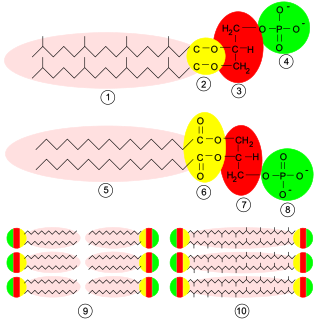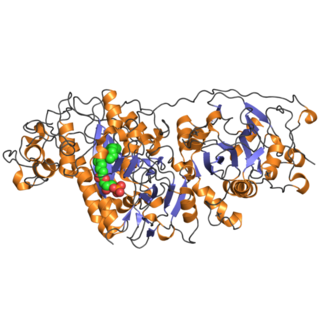Related Research Articles
Phosphatidic acids are anionic phospholipids important to cell signaling and direct activation of lipid-gated ion channels. Hydrolysis of phosphatidic acid gives rise to one molecule each of glycerol and phosphoric acid and two molecules of fatty acids. They constitute about 0.25% of phospholipids in the bilayer.

Glycerophospholipids or phosphoglycerides are glycerol-based phospholipids. They are the main component of biological membranes. Two major classes are known: those for bacteria and eukaryotes and a separate family for archaea.

In an organic chemistry general sense, an ether lipid implies an ether bridge between an alkyl group and an unspecified alkyl or aryl group, not necessarily glycerol. If glycerol is involved, the compound is called a glyceryl ether, which may take the form of an alkylglycerol, an alkyl acyl glycerol, or in combination with a phosphatide group, a phospholipid.

Lipid signaling, broadly defined, refers to any biological signaling event involving a lipid messenger that binds a protein target, such as a receptor, kinase or phosphatase, which in turn mediate the effects of these lipids on specific cellular responses. Lipid signaling is thought to be qualitatively different from other classical signaling paradigms because lipids can freely diffuse through membranes. One consequence of this is that lipid messengers cannot be stored in vesicles prior to release and so are often biosynthesized "on demand" at their intended site of action. As such, many lipid signaling molecules cannot circulate freely in solution but, rather, exist bound to special carrier proteins in serum.

Lysophosphatidic acid (LPA) is a phospholipid derivative that can act as a signaling molecule.

Autotaxin, also known as ectonucleotide pyrophosphatase/phosphodiesterase family member 2, is an enzyme that in humans is encoded by the ENPP2 gene.

Lysophosphatidic acid receptor 1 also known as LPA1 is a protein that in humans is encoded by the LPAR1 gene. LPA1 is a G protein-coupled receptor that binds the lipid signaling molecule lysophosphatidic acid (LPA).

Sphingosine-1-phosphate receptor 3 also known as S1PR3 is a human gene which encodes a G protein-coupled receptor which binds the lipid signaling molecule sphingosine 1-phosphate (S1P). Hence this receptor is also known as S1P3.

Lysophosphatidic acid receptor 4 also known as LPA4 is a protein that in humans is encoded by the LPAR4 gene. LPA4 is a G protein-coupled receptor that binds the lipid signaling molecule lysophosphatidic acid (LPA).

Sphingosine-1-phosphate receptor 4 also known as S1PR4 is a human gene which encodes a G protein-coupled receptor which binds the lipid signaling molecule sphingosine 1-phosphate (S1P). Hence this receptor is also known as S1P4.

Lysophosphatidic acid receptor 2 also known as LPA2 is a protein that in humans is encoded by the LPAR2 gene. LPA2 is a G protein-coupled receptor that binds the lipid signaling molecule lysophosphatidic acid (LPA).

Lysophosphatidic acid receptor 6, also known as LPA6, P2RY5 and GPR87, is a protein that in humans is encoded by the LPAR6 gene. LPA6 is a G protein-coupled receptor that binds the lipid signaling molecule lysophosphatidic acid (LPA).

G protein coupled receptor 132, also termed G2A, is classified as a member of the proton sensing G protein coupled receptor (GPR) subfamily. Like other members of this subfamily, i.e. GPR4, GPR68 (OGR1), and GPR65 (TDAG8), G2A is a G protein coupled receptor that resides in the cell surface membrane, senses changes in extracellular pH, and can alter cellular function as a consequence of these changes. Subsequently, G2A was suggested to be a receptor for lysophosphatidylcholine (LPC). However, the roles of G2A as a pH-sensor or LPC receptor are disputed. Rather, current studies suggest that it is a receptor for certain metabolites of the polyunsaturated fatty acid, linoleic acid.

Lysophosphatidic acid receptor 5 also known as LPA5 is a protein that in humans is encoded by the LPAR5 gene. LPA5 is a G protein-coupled receptor that binds the lipid signaling molecule lysophosphatidic acid (LPA).

Lysophosphatidic acid receptor 3 also known as LPA3 is a protein that in humans is encoded by the LPAR3 gene. LPA3 is a G protein-coupled receptor that binds the lipid signaling molecule lysophosphatidic acid (LPA).

Lipid phosphate phosphohydrolase 3 (LPP3), also known as phospholipid phosphatase 3 (PLPP3) and phosphatidic acid phosphatase type 2B, is an enzyme that in humans is encoded by the PPAP2B gene on chromosome 1. It is ubiquitously expressed in many tissues and cell types. LPP3 is a cell-surface glycoprotein that hydrolyzes extracellular lysophosphatidic acid (LPA) and short-chain phosphatidic acid. Its function allows it to regulate vascular and embryonic development by inhibiting LPA signaling, which is associated with a wide range of human diseases, including cardiovascular disease and cancer, as well as developmental defects. The PPAP2B gene also contains one of 27 loci associated with increased risk of coronary artery disease.

1-acyl-sn-glycerol-3-phosphate acyltransferase alpha is an enzyme that in humans is encoded by the AGPAT1 gene.

The human gene AGK encodes the enzyme mitochondrial acylglycerol kinase.

2-acyl-sn-glycero-3-phosphocholines are a class of phospholipids that are intermediates in the metabolism of lipids. Because they result from the hydrolysis of an acyl group from the sn-1 position of phosphatidylcholine, they are also called 1-lysophosphatidylcholine. The synthesis of phosphatidylcholines with specific fatty acids occurs through the synthesis of 1-lysoPC. The formation of various other lipids generates 1-lysoPC as a by-product.
![<span class="mw-page-title-main">Gintonin</span> Protein found in [[ginseng]]](https://upload.wikimedia.org/wikipedia/commons/thumb/c/c0/Gintonin_structure.jpg/320px-Gintonin_structure.jpg)
Gintonin is a glycolipoprotein fraction isolated from ginseng. The non-saponin ingredient was designated as gintonin, where gin was derived from ginseng, ton from the tonic effects of ginseng, and in from protein. The main component of gintonin is a complex of lysophosphatidic acids (LPA) and ginseng proteins such as ginseng major latex-like protein151 (GLP151) and ginseng ribonuclease-like storage protein.
References
- 1 2 Chun J, Goetzl EJ, Hla T, Igarashi Y, Lynch KR, Moolenaar W, Pyne S, Tigyi G (2002). "International Union of Pharmacology. XXXIV. Lysophospholipid receptor nomenclature". Pharmacol Rev. 54 (2): 265–9. doi:10.1124/pr.54.2.265. PMID 12037142.
- ↑ Meyer zu Heringdorf D, Jakobs KH (2007). "Lysophospholipid receptors: signalling, pharmacology and regulation by lysophospholipid metabolism". Biochim Biophys Acta. 1768 (4): 923–40. doi: 10.1016/j.bbamem.2006.09.026 . PMID 17078925.
- ↑ Choi JW, Herr DR, Noguchi K, Yung YC, Lee CW, Mutoh T, Lin ME, Teo ST, Park KE, Mosley AN, Chun J (January 2010). "LPA Receptors: Subtypes and Biological Actions". Annual Review of Pharmacology and Toxicology. 50 (1): 157–186. doi:10.1146/annurev.pharmtox.010909.105753. PMID 20055701.
- ↑ Pasternack SM, von Kügelgen I, Aboud KA, Lee YA, Rüschendorf F, Voss K, Hillmer AM, Molderings GJ, Franz T, Ramirez A, Nürnberg P, Nöthen MM, Betz RC (March 2008). "G protein-coupled receptor P2Y5 and its ligand LPA are involved in maintenance of human hair growth". Nat. Genet. 40 (3): 329–34. doi:10.1038/ng.84. PMID 18297070.